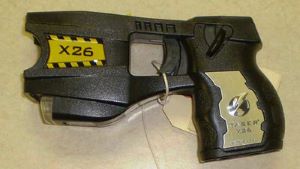
You love going to the dog park, and so does Fido.
I mean, come on.
It’s a place where he can run, play fetch, socialize with other dogs, and generally goof off.
Lately, there’s been a few new dogs around, though, and they’re a bit aggressive.
One of the other fur kid’s parents started bringing a taser to the park.
They say it’s a good tool to have when facing an aggressive dog.
According to them, you can stop a dog attack or break up a dog fight with it.
So, you wonder, is this true?
And, more importantly, is it safe?
I mean, that thing is strong.
You’ve seen videos where it knocks out grown men the size of Shaq, so what will it do to a dog?
Could it maybe even kill a dog? You’re all for protecting your fur kid, but you don’t want to harm the aggressive dog.
How Likely is it That You Will Be Attacked By A Dog?
So, dog bite statistics are a bit of a mixed bag. The Center of Disease Control (CDC) reports that there are around 4.5 million dog bites per year in the US. Luckily, only around 800 000 of those are severe enough to warrant medical care. That’s still a lot of people. Let’s put this in perspective. The total US population is just shy of 331.5 million, so the total amount of dog bites per year affects 1.4% of the population.
Dogs bite for many different reasons, most of them being fear, perceived danger, or self-defence. So, behaving well around fur kids decreases the risk of being bitten. Also, you’re far more likely to die from cataclysmic storms, contact with hornets, and choking on food than from a dog bite.
Statistically, the dog breeds most likely to bite you include Chihuahua, English Bulldog, Pitbull, and German Shepherd, among others. There isn’t really a correlation to size here.
The severity of dog bites, and the type of injury you’re likely to get, varies quite a bit, and is measured on a scale from 1 to 6. At level 1, the pup’s teeth didn’t even touch your skin. The poor thing is just trying to warn you off, not hurt you. At Level 4, the dog means business, really sinking his teeth into your skin and shaking his head while doing so. Here, things get serious. Level 5 involves multiple serious bites, while at Level 6, the victim dies as a result of the attack. Luckily, this is rare. Most dog bites are at Level 1 and 2, where the victim suffers minor bruises and hardly ever needs medical attention.
Can a taser kill a dog?
This is a controversial question. According to Taser Inc, Tasers are safe for humans and most dogs. But, some dogs have died after being tased. Most of these were large dogs, such as Pitbulls. We don’t know if these dogs had underlying medical conditions that made them more susceptible to succumb to these attacks or if the tasers could outright be blamed for their deaths.
Tasers administer an electric current to the body, causing ventricular fibrillation. In laymen’s terms, it shocks the body, causing the heart’s rhythm to change temporarily. If this shock is strong enough, the victim can die. Bear in mind that the lethal threshold for smaller animals is lower than for their larger cousins. This seems obvious, right? So, your little Yorkie would die from a much lower voltage than your St Bernard.
So, in short: some dogs have died after being shocked with tasers, while others lived to tell the tale.
Can tasers cause permanent damage to a dog?
Tasers deliver short bursts of electricity at low amperage. This isn’t supposed to cause any permanent damage or long-term side effects. Your dog’s size and general health play a role here. Smaller dogs, or dogs that already have underlying medical conditions that put them at risk, will suffer more significant harm than large, healthy dogs. So, if you’re contemplating using a taser, think twice before using it on small dogs.
Can a taser stop a dog attack?
Most dogs aren’t likely to get aggressive when trained and treated correctly. Unfortunately, this isn’t always the case, and sometimes dogs attack people and each other. If a dog does attack you, a taser would most definitely stop him in his tracks. Things could end badly for him, though. As we mentioned earlier, leave this as a last resort. And don’t take a taser to a dog park. There are better ways to stop a dog attack or break up a dog fight.
Why are dogs afraid of tasers?
Dogs don’t like loud noises, bright lights, or nasty surprises. The taser encompasses all of these in one package. It makes a loud crackling sound when you discharge a taser, almost like a lightning bolt. At the same time, it creates a bundle of sparks. This happens quite suddenly, so the dog has no warning that this scary monster is about to be unleashed. The poor pup will probably be scared out of his wits.
What’s the difference between a stun gun and a taser?
First off, taser is a brand, and there are other similar products available in the market. Taser’s products are ranged self-defense weapons. This means they can reach a potential attacker before they get to you. These devices typically have a reach ranging from 5 feet to 25 feet. They administer shock for between 5 and 20 seconds, depending on the model.
So, tasers administer pain and prolonged shock to large muscle groups. When a taser makes proper contact with an attacker, he will experience pain, muscle contractions and potentially pass out for a bit.
On the other hand, stun guns are contact self-defense weapons. The stun gun must physically contact the attacker’s skin to work. So, they have no range, and you have to wait for the attacker to reach you before you can use them. It also administers pain but not the same electric current as the taser. So, when the stun gun makes proper contact with a person, he’ll experience intense pain in the contact area, and that’s about it.
Tasers will work only once per charge. It’s all done when you discharge those wires unless you have a spare cartridge on you—kind of like reloading bullets. Luckily, you can remove that cartridge and use the taser as a stun gun. Unfortunately, this takes away the range advantage, so you’ll have to get into close contact with your attacker.
Will a stun gun stop a dog attack?
You’ll obviously be close enough to use a stun gun when a dog attacks you. If you can get it out in time, it’s very effective at stopping a dog attack. Here, the dog will experience intense, localized pain for as long as the stun gun is in contact with his skin, and it’s very effective at stopping a dog attack.
If two dogs are fighting each other, this might be less effective. Here, you’ll have to get close enough to the action to use the stun gun, which in itself is really dangerous. It puts you at risk of being bitten as well. Then, there’s the dogs’ fight-or-flight reaction. These dogs are already pumped with adrenaline and fighting, so adding more pain to the equation might hype them up even further.
What are other ways to stop a dog attack?
Tasers could be lethal, and stun guns only work in close proximity. So, you might need an alternative to stop a dog attack or break up a dog fight. It all boils down to scaring or distracting the attacking dog long enough for you to get away or get your furkid out of harm’s way.
Here are some options:
- Throw some water on the fighting dogs – the colder, the better. This should distract them long enough to stop fighting.
- Loud noises. Sounding an air horn or banging metal objects together could work. Pots and pans are often used if you can grab them quickly enough.
- Some dogs will stop attacking if they can’t see the other dog or person. In these cases, covering the dog’s head and body with a blanket or jacket will help them calm down.
- This one is potentially controversial. Some forms of pepper spray are formulated specifically for dogs. This will irritate their eyes, nose, and skin for a bit, temporarily incapacitating them and buying you time to get out of harm’s way. Before opting to use this, study the manufacturer’s guidelines on using it correctly.
How to Prevent a Dog Attack
The best way of stopping a dog attack is to prevent it from happening in the first place. There are two basic options: avoiding the potentially aggressive dog or scaring the dog away. Dogs are usually scared away when you show dominance.
It’s not always possible to avoid a potentially aggressive dog, especially when roaming the streets without a leash. If you see a potentially dangerous situation looming, change the direction you’re walking in, get out of the dog park, or do whatever is needed to get out of the way. That’s usually the best and safest option.
If you can’t get away, you’ll have to scare off the potential attacker. The most effective way is to use really loud noises. Yelling won’t do it, though. Rather bang pots together or “dry fire” a stun gun. It makes a super loud crackling sound, like a lightning bolt, and it’s very effective. It also makes a bright flashing light, which helps make the point that you’re the alpha here.
Photo credits
¹ Photo by Charles LeBlanc on Flickr





